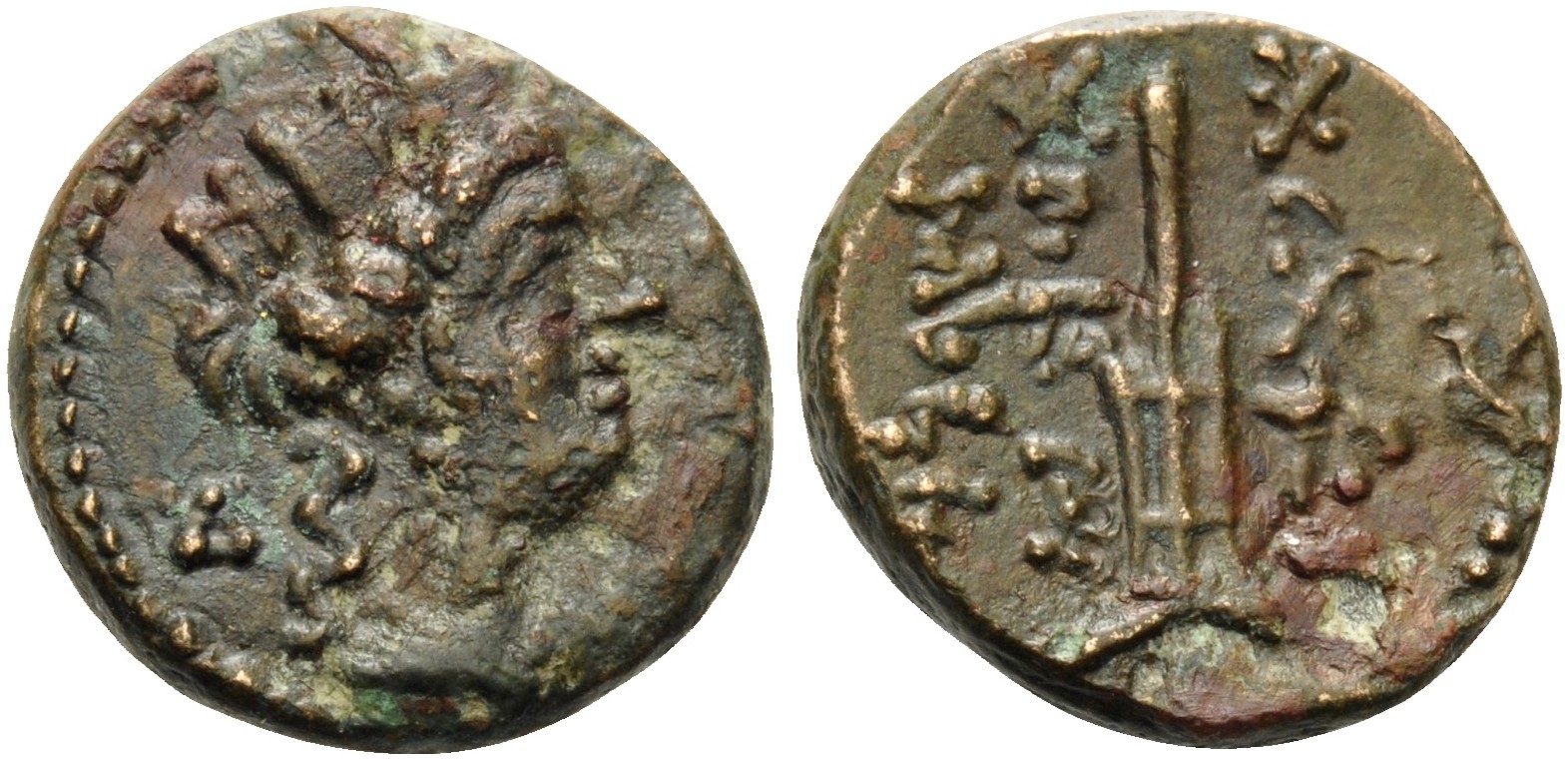Sidon, bronze, Module E (Tyche/rudder) (114-110 BCE)
From SILVER
114 BCE - 110 BCE Bronze
Description
| ObverseInscription or printing placed on the obverse.: | Bust of Tyche right, wearing mural crown and a drapery. In the field, one/several letter(s) or monogram. Border of dots. |
| ReverseInscription or printing placed on the reverse.: | LSDNM ('M KMB 'P KTSR) (Phoenician).Different types: 1) Rudder. Border of dots, 2) Europa seated on Zeus metamorphosed in a bull left, holding her veil inflated by the wind above her head. Border of dots. |
Mint and issuing power
| MintIdentifies the place of manufacture or issue of a numismatic object.: | Sidon | Ancient regionAncient region.: | Phoenicia | Modern countryModern country: Lebanon | AuthorityIdentifies the issuing power. The authority can be "pretended" when the name or the portrait of X is on the coin but he/she was not the issuing power. It can also be "uncertain" when there is no mention of X on the coin but he/she was the issuing power according to the historical sources: |
Chronology
| FromIdentifies the initial date in a range assigned in a numismatic context. | 114 BCE | toIdentifies the final date in a range assigned in a numismatic context.. | 110 BCE | PeriodTime period of the numismatic object.: Hellenistic 323-30 BC |
Physical description
| MetalThe physical material (usually metal) from which an object is made.: | Bronze |
Median weightMedian of the weights of numismatic objects (in grams). in grams | 1.80 | DenominationTerm indicating the value of a numismatic object. Examples: tetradrachm, chalkous, denarius.: | Module E | StandardStandard.: |
Image

S990 Sidon.jpg [1]
References
| Die study referencePublication of the study: | Abou Diwan 20121Abou Diwan 2012, p. 97-98, n° 90-113 | ||
| Coin series referenceReference to coin series study: | Sear II2Sear II, n° 5958, HGC 103HGC 10, 296 | ||
Obverse dies distribution
| FrequencyFrequency of specimen in distribution. ᵖ | Number of obversesNumber of obverse dies. ᵖ (o) | % (o) | Number of coinsNumber of coins. (n) | % (n) | Die nameName(s) of the die(s). |
| 1 | 7 | 63.64 | 7 | 38.89 | 2R, 3R, 5R, 6R, 7R, 8R, 9R |
| 2 | 2 | 18.18 | 4 | 22.22 | 1E, 2E |
| 3 | 1 | 9.09 | 3 | 16.67 | 1R |
| 4 | 1 | 9.09 | 4 | 22.22 | 4R |
| Total | 11 of 11 | 100 | 18 of 18 | 100 |
Reverse dies distribution
no distribution is available
Quantification
| Number of obversesNumber of obverse dies. ᵖ (o) | 11 | Number of singletons (o1)The number of singleton coins. ᵖ | 7 |
| Number of reverse diesNumber of reverse dies. (r) | 18 | Number of coinsNumber of coins. (n) | 18 |
| Coins per obverse dieNumber of coins per obverse die. (n/o) | 1.64 | Coins per reverse dieNumber of coins per reverse die. (n/r) | 1 |
| Reverse per obverse ratioRatio of obverse dies divided by reverse dies. (r/o) | 1.64 | Percentage of singletons (o1)number of coins (n) divided by the number of singletons (o1) ᵖ | 63.64 % |
| Original number of dies (O) (Carter 1983 formula)The estimation of the number of coins according to Carter 1983 ᵖ | 22.8 | Coins struck if 20,000 as average productivity per dieCoins made if the average productivity for obverses (according to Carter) is 20,000. ᵖ | 456,000 |
| Original number of dies (O) (Esty 2011 formula)The estimation of the number of coins according to the singleton formula in Esty 2011 ᵖ (O) | 28.29 | Survival rate if 20,000 as average productivity per dieSurvival rate if average productivity is 20,000. ᵖ | 0.00004 |
| Coverage (o = % of O) (Esty 1984 formula)Esty 1984 - coverage (% of O) ᵖ (o = % of O) | 61.11% | Die productivity if survival rate 1/2,000Average productivity if survival rate is 1/2,000. ᵖ | 1,578.95 |
| Weight of silver (in kg) if 20,000 coins per die (O = Carter formula)Carter 1983 * Median weight * 20000 (*10 if gold or electrum) ᵖ | n.a. | Die productivity if survival rate 1/5,000Average productivity if survival rate is 1/5,000. ᵖ | 3,947.37 |
Remarks
Most likely one single workstation Likely not military "R" is for "rudder", "E" is for "Europa"
References
- ^ Abou Diwan, Georges (2012), "Le monnayage civique non daté de Sidon: Opportunisme civique et pragmatisme royal (169/8-111/0 av. J.-C.)", American Journal of Numismatic, 24, p. 91-121.
- ^ Sear, David R. (1979), Greek coins and their values. Vol. II, Asia and North Africa, London, xlviii, p. 317-762
- ^ Hoover, Oliver D. (2010), The Handbook of Greek Coinage Series. 10. handbook of coins of the Southern Levant : Phoenicia, southern Koile Syria (including Judaea), and Arabia, Lancaster-London, lxxix, 201 p.